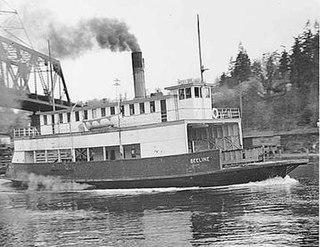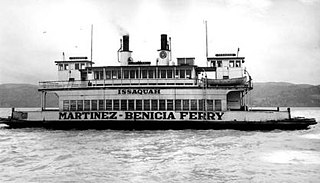
The Pacific Wharf Company was a corporation which once controlled much of the waterfront of Port Townsend, Washington.

The Pacific Wharf Company was a corporation which once controlled much of the waterfront of Port Townsend, Washington.
Pacific Wharf Company was formed in 1891 by Charles E. Peabody (1857-1926), Walter Oakes, George T. Roberts, and others. The company was formally incorporated on August 8, 1891. According to the articles of incorporation, the company's capital was $59,000. The major stockholders included Charles E. Peabody (200 shares), D.B. Jackson, and Walter Oakes (118 shares each). Oakes was named as chairman of the board of directors and Peabody as president. Peabody and Oakes were well-connected businessmen. Roberts was a steamship captain. Jackson was a successful businessman and a steamboat purser. [1]
The Pacific Wharf Company owned a wharf and other waterfront holdings in Port Townsend, Washington. [1]
Through corporate reorganizations, Pacific Wharf Company later came under the control of the Puget Sound Navigation Company, which was formed in 1903. [1]

The Puget Sound Navigation Company (PSNC) was founded by Charles E. Peabody in 1898. It operated a fleet of steamboats and ferries on Puget Sound in Washington and the Georgia Strait in British Columbia. Known colloquially as the Black Ball Line, the PSNC achieved a "virtual monopoly" on cross-sound traffic in the 1930s and competed with the Canadian Pacific Railway's steamships on several routes.

The steamboat Defiance operated in the early 1900s as part of the Puget Sound Mosquito Fleet. In later years this vessel was called Kingston.

The steamboat Monticello (2) operated in the early 1900s as part of the Puget Sound Mosquito Fleet. The vessel went through several reconstructions and remained in service until 1962, when she was lost in Alaska waters. Her later names were Penaco and Sea Venture. (This Puget Sound steamer should not be confused with the smaller Monticello, which also ran on Puget Sound, but was built in 1895 for Captain Z.J. Hatch of the Monticello Steamship Company.

The steamboat Rosalie operated from 1893 to 1918 as part of the Puget Sound Mosquito Fleet, also operating out of Victoria, B.C. In 1898, Rosalie went north with many other Puget Sound steamboats to join the Klondike Gold Rush.

Colman Dock, also called Pier 52, is the primary ferry terminal in Seattle, Washington, United States. The original pier is no longer in existence, but the terminal, now used by the Washington State Ferry system, is still called "Colman Dock".
The Kitsap County Transportation Company was an important steamboat and ferry company that operated on Puget Sound. The company was founded in 1898 as the Hansen Transportation Company.
The La Conner Trading and Transportation Company was founded in the early 1900s by Joshua Green and others, to engage in the shipping business on Puget Sound.

Florence K was a steamboat that was operated on Puget Sound from 1903. This vessel was later renamed Gloria and was rebuilt as a steam ferry and renamed Beeline.

Inland Flyer was a passenger steamboat that ran on Puget Sound from 1898 to 1916. From 1910 to 1916 this vessel was known as the Mohawk. The vessel is notable as the first steamer on Puget Sound to use oil fuel. Inland Flyer was one of the most famous vessels of the time on Puget Sound.

General Miles was a steamship constructed in 1882 which served in various coastal areas of the states of Oregon and Washington, as well as British Columbia and the territory of Alaska. It was apparently named after US General Nelson A. Miles.

Issaquah was a steam ferry built in 1914 that operated on Lake Washington and in San Francisco Bay.

City of Mukilteo was a steam ferry built in 1927 which served on Puget Sound until April 1932, when the ferry was destroyed by fire.

City of Clinton was a small steam ferry built in 1922 which served on Puget Sound until March 23, 1929, when the vessel caught fire and sank near the city of Mukilteo, Washington, USA.

C.C. Calkins was a small steamboat built in 1890 which served on Lake Washington.

Kirkland was a sidewheel steamboat that ran on Lake Washington from 1888 to 1898.

Kulshan was a steamship which operated on Puget Sound from 1910 until 1929. When built, Kulshan was one of a newer type of inland steamships constructed entirely of steel, and was then considered one of the finest vessels ever to operate on Puget Sound.

Sol Duc was a steamship which was operated on northern Puget Sound from 1912 to 1935, chiefly on a route connecting ports on the Olympic Peninsula with Seattle. During the Second World War (1941–1945) Sol Duc served as a barracks ship.

Camano was a steamboat built in 1906 at Coupeville, Washington which operated on Puget Sound from 1906 to 1917. Camano was later known as Tolo. As Tolo the vessel was sunk in 1917 as a result of a collision at sea. Four people died as a result.
The People's Wharf Company owned a wharf in Port Angeles, Washington. it was part of the Puget Sound Navigation Company which held a near-monopoly on passenger and ferry transportation on Puget Sound until 1951.

Speeder was a motor launch built in 1908 which served on Puget Sound and in the San Juan Islands. From 1908 to 1922 this vessel was named Bainbridge.